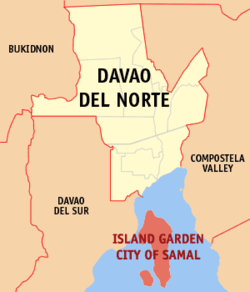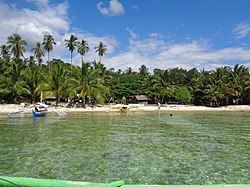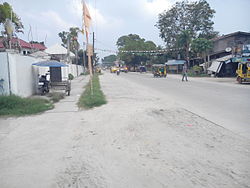This article needs additional citations for verification .(April 2014) |
Samal | |
|---|---|
| Island Garden City of Samal | |
 | |
 Map of Davao del Norte, Davao with Samal highlighted | |
Location within the Philippines | |
| Coordinates: 7°03′N125°44′E / 7.05°N 125.73°E | |
| Country | |
| Region | Davao del Norte, Davao |
| Province | Davao del Norte, Davao |
| District | 2nd district |
| Founded | July 8, 1948 |
| Cityhood | January 30, 1998 |
| Barangays | 46 (see Barangays) |
| Government | |
| • Type | Sangguniang Panlungsod |
| • Mayor | Lemuel Tesorero Reyes |
| • Vice Mayor | Al David T. Uy |
| • Representative | Alan R. Dujali |
| • City Council | Members |
| • Electorate | 87,944 voters (2025) |
| Area | |
• Total | 301.30 km2 (116.33 sq mi) |
| Elevation | 32 m (105 ft) |
| Highest elevation (Mount Puting-Bato) | 535 m (1,755 ft) |
| Lowest elevation | 0 m (0 ft) |
| Population (2024 census) [3] | |
• Total | 119,701 |
| • Density | 400/km2 (1,000/sq mi) |
| • Households | 29,973 |
| Economy | |
| • Income class | 4th city income class |
| • Poverty incidence | 9.93 |
| • Revenue | ₱ 1,395 million (2022) |
| • Assets | ₱ 2,938 million (2022) |
| • Expenditure | ₱ 1,119 million (2022) |
| • Liabilities | ₱ 990.8 million (2022) |
| Service provider | |
| • Electricity | Northern Davao Electric Cooperative (NORDECO) |
| Time zone | UTC+8 (PST) |
| ZIP code | 8118 (Babak), 8119 (Peñaplata), 8120 (Kaputian) [5] |
| PSGC | |
| IDD : area code | +63 (0)84 |
| Native languages | Davawenyo Cebuano Ata Manobo Kalagan Tagalog |
| Website | samalcity |
Samal, officially the Island Garden City of Samal (IGaCOS; Cebuano : Pulong Harding Dakbayan sa Samal; Filipino : Pulong Harding Lungsod ng Samal) is a component city in the province of Davao del Norte, Philippines. According to the 2020 census, it has a population of 116,771 people. [6]
Contents
- Etymology
- History
- Early beginnings
- World War 2
- Official founding of the municipality
- Proposed province
- Cityhood
- Hostage crisis
- Geography
- Climate
- Barangays
- Demographics
- Economy
- Agriculture
- Tourism
- Fishing
- Government
- Transportation
- Proposed Samal-Davao Bridge
- Sister cities
- Local
- See also
- References
- External links
It is made up of Samal Island and the smaller Talikud Island in Davao Gulf, from the merger of former municipalities of Samal, Babak, and Kaputian.
Samal is a part of the Metropolitan Davao area and is two kilometers away from Davao City, in mainland Mindanao, the largest city and the primary economic center of that island.









